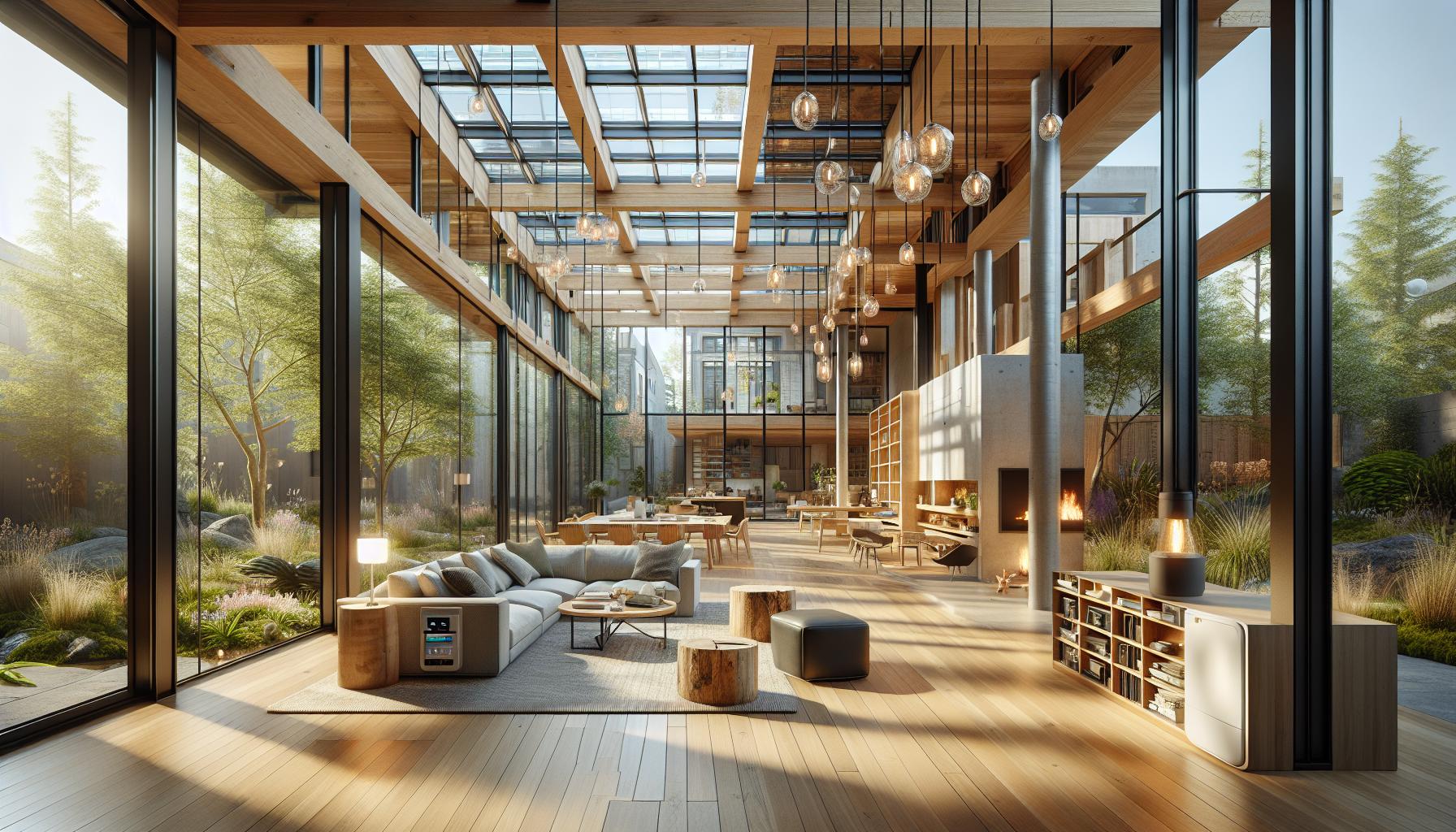Seattle’s vibrant blend of culture and innovation makes it an exciting place to call home. Yet, as the city evolves, so do the needs of homeowners seeking to enhance their living spaces. Whether you’re dreaming of a modern kitchen upgrade or a cozy basement retreat, renovating your Seattle home can be both thrilling and daunting.
Navigating the unique architectural styles and weather considerations of the Pacific Northwest requires a thoughtful approach. I’ve discovered that understanding local trends and building codes is crucial to a successful renovation. From eco-friendly materials to maximizing natural light, there’s plenty to consider when planning your project.
In this article, I’ll explore essential tips and insights to help you transform your Seattle home into a sanctuary that reflects your personality and meets your needs. Let’s dive into the world of Seattle home renovation and uncover the potential hidden within your walls.
Key Takeaways
- Navigating Seattle’s unique architectural styles and building codes is essential for a successful home renovation, with a focus on understanding local regulations and trends.
- The wet climate of the Pacific Northwest necessitates moisture-resistant and energy-efficient materials in Seattle renovations to ensure durability and comfort.
- Sustainable home designs, incorporating eco-friendly materials and smart technologies, are increasingly popular among Seattle homeowners looking to minimize their environmental impact.
- Successful Seattle renovations often include maximizing natural light through open floor plans, large windows, and skylights, crucial for enhancing living spaces in the city’s overcast climate.
- Collaborating with knowledgeable local contractors familiar with Seattle’s regulations can streamline the renovation process, ensuring compliance and avoiding costly errors.
- Effective budget management, including allocating funds for necessary weatherproofing, is crucial for achieving desired renovation outcomes without financial strain.
Seattle Home Renovation
Seattle’s home renovation industry offers diverse opportunities for enhancing residential spaces. With the city’s architectural variety, homeowners can opt for modern, craftsman, or mid-century styles. Balancing aesthetics with functionality is key in transforming homes to suit urban lifestyles.
Seattle’s wet climate requires materials that resist moisture and promote energy efficiency. Roofing choices like metal or composite shingles and advanced insulation methods are popular. On average, homeowners allocate about 30% of renovation budgets to weatherproofing solutions.
Permits and codes are critical, as Seattle mandates strict compliance with municipal regulations. Homeowners often collaborate with licensed contractors familiar with city guidelines. This partnership ensures that designs meet safety standards and zoning laws satisfactorily.
Sustainability is a trend, with many renovations incorporating eco-friendly materials like reclaimed wood and low-VOC paints. Energy-efficient appliances and solar panels are frequently included to reduce environmental impact. This approach caters to Seattle’s environmentally conscious population.
The desire to maximize natural light influences design choices. Open floor plans and large windows are common features. Many homeowners install skylights or glass doors for additional luminosity, catering to the city’s often overcast weather.
Popular Renovation Trends In Seattle

Seattle homeowners embrace a blend of sustainability and technology to modernize spaces. They adopt designs that enhance comfort, efficiency, and style.
Sustainable And Green Design
Homeowners incorporate eco-friendly materials in renovations. Bamboo flooring, reclaimed wood, and recycled glass countertops are popular choices. Energy-efficient appliances like low-flow faucets and LED lighting align with Seattle’s green ethos. Solar panels cut energy costs and reduce environmental impacts.
Smart Home Features
Integrated smart technology enhances convenience. Voice-controlled systems manage lighting, security, and temperature. Wi-Fi-enabled appliances, such as smart refrigerators and ovens, offer remote accessibility. Smart thermostats optimize energy use, important for Seattle’s varying climate.
Open Living Spaces
Expanding spaces creates light and fluidity. Open floor plans remove walls to connect kitchens, dining, and living areas. Large windows and skylights maximize natural light, essential for the city’s overcast conditions. Sliding glass doors extend living spaces to outdoor areas, encouraging indoor-outdoor flow.
Key Considerations For Seattle Renovations

Seattle renovations require careful planning due to local regulations, climate factors, and budget constraints. Each element plays a critical role in ensuring a successful home transformation.
Local Building Regulations
Understanding and adhering to Seattle’s stringent building codes is essential. Local ordinances dictate everything from structural changes to aesthetic modifications. I work closely with licensed contractors to navigate these requirements, ensuring every aspect of my design complies with city safety standards and zoning laws. This collaboration minimizes risks of delays and legal issues, helping streamline the renovation process.
Climate Considerations
Seattle’s wet climate impacts renovation choices significantly. Moisture-resistant materials are a priority to prevent mold and quality deterioration. Energy efficiency also takes precedence to combat the cold, damp weather. By incorporating features like double-glazed windows and advanced insulation, I tackle these challenges effectively. Selecting weatherproof materials and solutions not only enhances durability but also ensures comfort.
Budget And Cost Management
Effective budget management is crucial in Seattle’s renovation projects. Allocating around 30% of a renovation budget for weatherproofing has proven necessary. To avoid unforeseen expenses and maintain financial control, I prepare detailed financial plans covering labor, materials, and contingency funds. This structured approach allows me to balance cost efficiency with quality, achieving desired outcomes without financial strain.
Finding The Right Contractor

Choosing the right contractor is crucial in ensuring a successful home renovation in Seattle. A good contractor helps navigate local regulations and achieve design goals within budget constraints.
Research And Recommendations
I start by gathering research on potential contractors through online platforms like Yelp and Angie’s List. Reading customer reviews gives insight into their reputation. Recommendations from friends, family, or neighbors who’ve recently completed renovations can provide reliable leads. I also attend local home renovation fairs to meet contractors personally, which helps in assessing their professionalism firsthand.
Evaluating Credentials
Checking contractor credentials is essential for compliance and quality assurance. I verify licenses and insurance details through the Washington State Department of Labor and Industries to ensure they’re valid and up-to-date. Requesting references from past clients is another step I take to gauge work quality and client satisfaction. Reviewing past renovation projects in their portfolio helps assess if the contractor’s style aligns with my vision.
Successful Renovation Stories In Seattle
Seattle homeowners often transform their homes into remarkable modern and historic spaces through innovative renovations. Here are some successful renovation stories that showcase the creative possibilities within the city.
Case Study 1: Modern Loft Conversion
In the heart of Seattle’s Capitol Hill, I transformed an outdated industrial space into a vibrant modern loft. The project emphasized open concepts and sustainable design. By removing interior walls, I created a spacious, flexible living area bathed in natural light. Full-height windows and skylights brightened the space, complementing the minimalist aesthetics. Eco-friendly elements included bamboo flooring and energy-efficient LED lighting. Smart home features, like automated blinds and voice-activated controls, enhanced convenience. The loft now embodies contemporary urban living while respecting sustainable principles.
Case Study 2: Historic Home Restoration
In Ballard, I worked on restoring a craftsman bungalow to preserve its original charm. The renovation journey balanced historical integrity with modern functionality. Meticulous craftsmanship restored period details like the original woodwork, stained glass, and intricate moldings. For modern convenience, I discreetly integrated advanced insulation and energy-efficient systems. The kitchen featured reclaimed wood cabinetry, maintaining the home’s vintage appeal. Modern appliances hidden behind period-appropriate facades upheld the historical ambiance. This meticulous restoration received acclaim for seamlessly blending the old with the new, ensuring the bungalow’s relevance in today’s urban landscape.
Tips For A Smooth Renovation Process
Embarking on a Seattle home renovation requires strategic planning and effective collaboration. Here are key considerations to ensure a seamless journey.
Planning And Preparation
Thorough planning sets the foundation for a successful renovation. I start by defining clear goals, focusing on necessary changes or desired features. Creating a detailed budget ensures resource allocation aligns with priorities, considering the local climate’s influence on material choices. I prepare a timeline, accounting for potential delays due to weather or permit processes. Engaging with Seattle-specific resources like local design forums or home improvement groups offers valuable insights into trends and regulations.
Communication With Contractors
Maintaining open communication with contractors is crucial. I schedule regular updates, ensuring alignment on project milestones and adjustments. Establishing a communication plan with preferred channels and response times mitigates potential misunderstandings. I document all critical decisions, capturing agreements or changes in scope. Seeking feedback from contractors on design feasibility or material selection informs better decisions, ultimately facilitating a smooth renovation experience.
Prioritizing Sustainability
Renovating a home in Seattle offers a unique opportunity to blend cultural richness with modern innovation. By embracing local architectural styles and prioritizing sustainability, homeowners can create spaces that reflect both personal taste and environmental consciousness. Navigating Seattle’s building codes and climate challenges requires careful planning and collaboration with experienced contractors. As homeowners integrate eco-friendly materials and smart technologies, they not only enhance their living spaces but also contribute to a greener future. With strategic planning and a focus on both aesthetics and functionality, Seattle homes can be transformed into beautiful, efficient sanctuaries that stand the test of time.
